Tut mir leid wenns diesmal wieder ein wenig länger wird.
(@Mods, nachdem es mit Vintage LPs und den Customshop Reissues zu tun hat, habs ichs einmal hier reingestellt, aber ich kann auch gerne einen Extra Thread aufmachen.)
Hintergrund:
Gestern abend Pekris Bavarian Makeover Thread gelesen, und heute morgen gewundert "wie war das noch einmal genau mit der 'historisch korrekten' Tailpiece Position?".
Und bevor ich jetzt einfach im Forum nachfrage, erstmal ein wenig selbst recherchieren.
Also Tante Google angeworfen, direkt in den Ami-Foren gelandet und dann ist es konfus geworden:
Laut LPF illustriert das hier die Vintage Position:
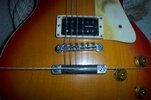 http://www.lespaulforum.com/forum/showthread.php?t=127648&highlight=Tailpiece+location
http://www.lespaulforum.com/forum/showthread.php?t=127648&highlight=Tailpiece+location
This is the vintage position. The tailpiece is slanted up on the high E side.
The High E stud anchor is 1/16" closer to the fretboard on vintage LP's
It creates a very particular symetrical alignment, as shown by the line in the photo
above, which runs through the center of the studs and touches the
edges of both volume pots. Examples are clearly seen in BOTB.
On a stock Historic that same line runs into the neck volume knob only.
Its visible on any straight on shot of a historic.
Heisst also verlängerte Linie entlang der Mitte des Tailpieces berührt beide Potiknöpfe.
Aber alleine in diesem Thread tauchen Sachen auf wie "das war 1958/59 ein Fehler, der 1960 korrigiert wurde". "Nein war kein Fehler, war Absicht" blabla.
Der Versuch das zu reproduzieren ist hier zu finden (nach John Cattos LP Plan Rev10):
http://www.lespaulforum.com/forum/showthread.php?t=113913&highlight=burst+tailpiece+angle
First of all, one thing to keep in mind is that the bridge on a Historic is in a slightly different position than a 50s bridge - it was minutely repositioned to help with intonation with modern strings. So well talk specifically about the tail piece.
There is a readily reliable measuring point from guitar to guitar - the frets. Not the end of the fingerboard; the frets, so lets use that. To do this test, I used John Cattos Les Paul layout plan, and my one remaining Historic Les Paul.
If you measure from the center of the 16th fret to the center line of each of the tail piece studs on a 50s Les Paul, the first thing youll do is confirm what people have intuitively known for a while: the tail piece on a 50s Les Paul isnt straight - its not perpendicular to the strings. Theres an offset of 1/16" - meaning the bass side is 1/16" further away from the finger board, or conversely, the treble side is 1/16" closer to the finger board. Using Johns layout plan, the center line bass side tail piece stud is 11 11/32" from the center of the 16th fret. The center line of the treble side tail piece stud is 11 9/32" from the 16th fret.
Do the same measurement on a Historic, and you find that the tail piece is perpendicular to the strings. And it is further away from the finger board than a 50 Les Paul. On my Historic, the center line of both tail piece studs is 11 15/32" away from the center line of the 16th fret.
So - myth confirmed: The tail piece of a Historic IS in the 'wrong place'.
Und rüber zum MLPF:
http://www.mylespaul.com/forums/historics-reissues/96390-proper-angle-tailpiece-bridge.html
I've seen mentioned repeatedly that Gibson hasn't gotten the angle on the stop tailpiece right.
Looking at a LOT of vintage photos, it looks to me more like it's the angle of the bridge that was different on the original bursts.
From what I can see, the bridge was angled down a little more on the treble side of the guitar, making the tailpiece and the bridge seem closer to being parallel.
A close look at the photos shows, to me, that the stop tail is always perpendicular to the body of the guitar. It's the bridge's angle that is different.
And I have to surmise that that they do this because of intonation.
Perhaps with the heavier strings they used in the 50s, intonation could be dialed in with the not-so-tilted bridge, but with the tiny strings we use in modern times, the distance to the nut on the higher strings is too great with the bridge angled down, thus the great angle of the modern bridge.
Maybe this is one of those cases where to make a guitar just like the originals would result in a non-intonatable guitar without using 12 gauge strings or heavier.
Dann wirds ein wenig kontrovers:
Bob, there seems to be a lot of confusion with regard to the tailpiece position and angle, and I'll do my best to set the record straight...as I see it.
For a few years, people were claiming that the tailpiece on vintage 'bursts were tilted, with the treble side being 1/16" or so closer to the neck than the bass side, and that Historics were wrong, because there's were straight (perpendicular to the center seam). And one of the main arguments cited was by using photos like this one which shows how a line drawn through the tailpiece studs on this vintage guitar intersects with both forward knobs:

More recently, however, some pretty well known and well respected Les Paul experts have made the claim that the tailpiece on most vintage LPs is actually straight (perpendicular to the center seam)...with a few exceptions, of course...like everything else in the world of vintage, hand made guitars. What the general feeling is now, at least from these experts, is that the tailpiece illusion shown above is due more to the knob positioning, rather than the tailpiece angle. In addition, as you noted above, the bridges had less of an angle to them back then, which made them almost parallel to the straight tailpieces.
So, bottom line is, that the tailpiece on Historics may be the only thing that is vintage accurate, and it's likely the knob position and bridge angle that varies from vintage.
But then again, I may be completely full o' shit, and I should just stick to eating pizzas, which is what I do best.
Was schliesslich zur Erwähnung von Kims "Offset Tailpiece studs" führt:
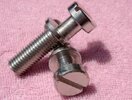
Yes the 50's pauls had the treble side tailpiece stud about 1/16 closer to the bridge,
some people actually go to the effort of moving the stud to be historically correct.
Or pop over to Historic Makeovers Retro Spec site and buy an offset stud. Gets the illusion without being an invasive mod.
ABER:
Correct. I actually have a few sets of those, and they look great. But even Kim, who sells those offset studs, admits that most vintage guitars (and virtually all those that he's measured) had straight tailpieces.
Ich bin ja nicht sicher, ob es dabei eine Illusion ist, denn das Tailpiece wird dabei ja wirklich leicht verdreht, nur die Schraubenverankerung bleibt an der gleichen Stelle.
Wobei das natürlich den Nachteil hat, daß man die Höhe des Tailpieces nur mehr in ganzen Umdrehungen anpassen kann.
OffsetStuds siehe hier:
http://www.mylespaul.com/forums/historics-reissues/90983-offset-tailpiece-studs-anyone.html
Da gehts dann wirklich zur Sache von wegen "Blödsinn", "nein kein Blödsinn, super!"
Der Spaß sieht dann montiert so aus:
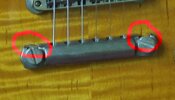
Sogar Les Paul wird dann nach diesem Video zitiert mit "basically they all sound the same"
http://www.youtube.com/watch?v=RyKL6dIiFIY#t=2m40s
Und selbst Kim schreibt dann noch:
http://www.mylespaul.com/forums/his...set-tailpiece-studs-anyone-2.html#post1769957
I do agree when your in a band situation and cranked through the amp, your not going to be able to make a/b comparisons, However we took a set of original 1959 tailpiece studs and and duplicated the steel properties.
The tonal change is in the steel compared to what ever is being made and put on the Historic models today.
Put a magnet to your studs and let me know how you make out there.
Now is the change for the better, That is going to be up to the the end user.
If you start with a good tone then send it to a cranked amp you will be in heaven.
What I'm saying is you get what you put into it. Only cranked!
Same goes with pickups.
There is no way you are going to test anything through a cranked amp.
If you listen at a real clean reasonable volume you will hear the difference.
Then crank that into your amp.
The crank in the tailpiece stud is purely cosmetic, However the steel studs are going to make a difference.
Wobei sich das IMHO nicht danach anhört, als ob der Winkel des Tailpieces einen besonderen Unterscheid macht, sondern eher das Material, also der Stahl den er verwendet.
Jedenfalls würde mich interessieren, wie Ihr das seht, denn einerseits scheint die Sache mit dem Tailpiecewinkel zumindest kontroversiell diskutiert zu werden, andererseits wenn Leute die sich wirklich auskennen wie Pekri oder Hoss diesen Unterschied als wichtig erachten, und Pekri sogar bei seinem Bavarian Makeover eher das Versetzen des Tailpieces in Betracht zieht, als die Offset Schrauben, dann wird wohl was dran sein.
P.S. bilde ich mir das ein, oder ist das MLPF ein wenig "trashiger" als das LPF. Mir kommt vor, daß in zweiterem die Leute ein wenig entspannter, ein bisschen mehr wie hier bei uns sind, oder täuscht das?


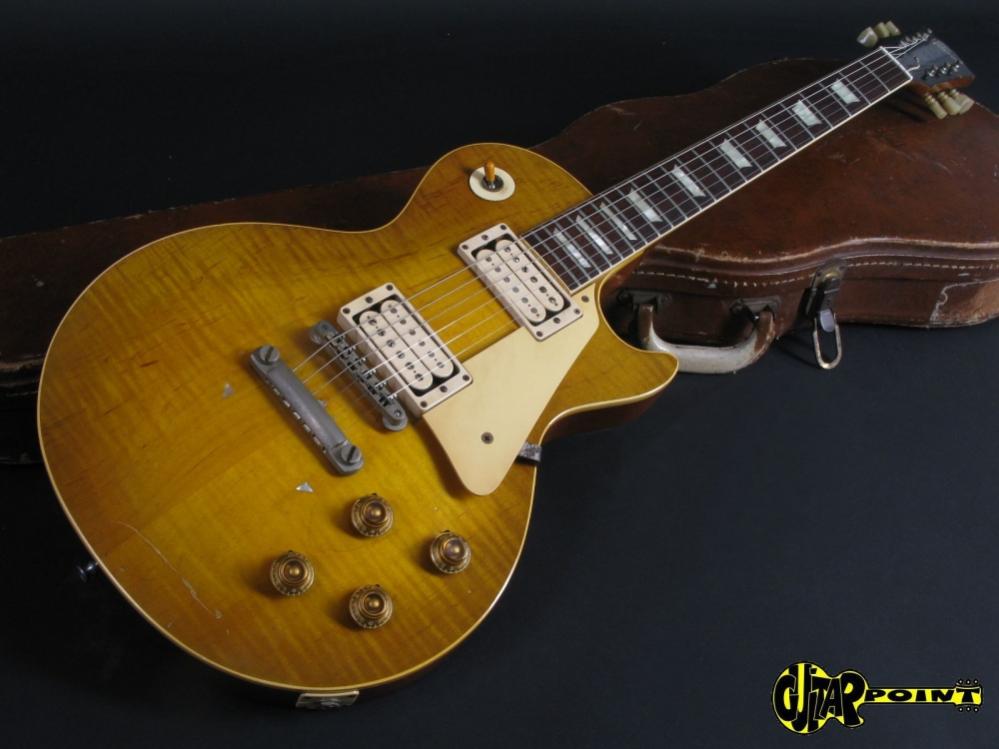

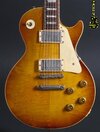
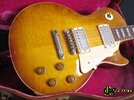
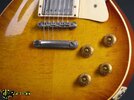



 ...
...


